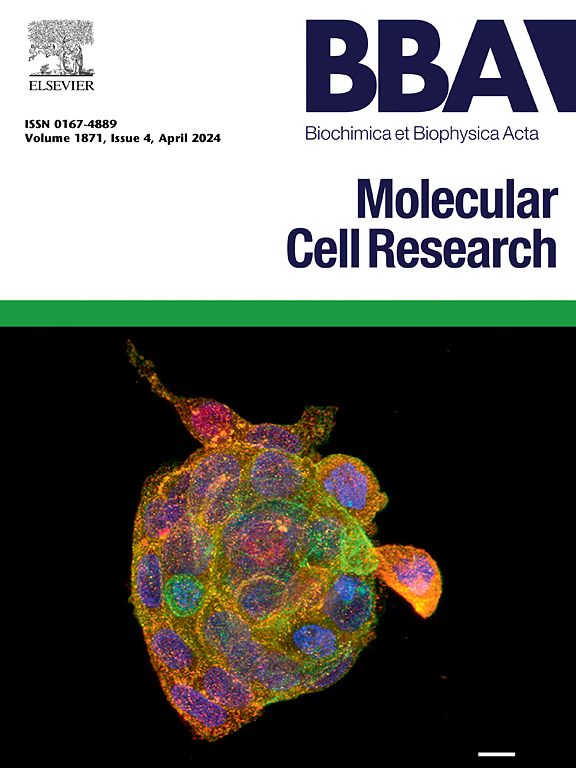Recombinant human ADAMTS13 attenuates LPS-induced acute kidney injury and renal microangiopathy in murine advanced liver fibrosis by cleaving vWF
IF 3.7
2区 生物学
Q1 BIOCHEMISTRY & MOLECULAR BIOLOGY
Biochimica et biophysica acta. Molecular cell research
Pub Date : 2025-06-09
DOI:10.1016/j.bbamcr.2025.120000
引用次数: 0
Abstract
Hepatorenal syndrome (HRS) has a poor prognosis among the complication of cirrhosis, yet treatment options are limited. Thrombotic microangiopathy with reduced ADAMTS13 activity and vWF accumulation has been reported to play a key role in the pathogenesis of acute kidney injury (AKI) in cirrhosis. This study investigated the effect of recombinant ADAMTS13 (rADAMTS13) on AKI with carbon tetrachloride (CCl4)-induced advanced liver fibrosis in mice. AKI was induced by intraperitoneal administration of acute insult with double dose of CCl4 and lipopolysaccharide (AKI-F mice), and mice were treated with rADAMTS13 (10 μg/body). AKI-F mice showed a marked liver dysfunction as well as renal dysfunction with elevated serum level of renal damage markers including kidney injury molecule-1, osteopontin, and neutrophil gelatinase-associated lipocalin. In AKI-F mice, reduced plasma ADAMTS13 activity and increased vWF antigen levels resulted in the decrease in hepatic and renal blood flow. Treatment with rADAMTS13 increased plasma ADAMTS13 activity, decreased vWF antigen levels leading to recovery of liver and kidney blood flow. Consequently, both hepatic and renal injuries showed serological and histopathologic improvements with decreased F4/80+ macrophage infiltration and 4-hydroxynonenal+ oxidative damage after rADAMTS13 treatment. The deposition of CD41a-positive microthrombi in kidney tissues observed in the AKI-F mice was significantly suppressed by treatment with rADAMTS13. Concomitantly, rADAMTS13 treatment promoted angiogenesis as well as inhibited vascular inflammation in the kidney of AKI-F mice. In conclusion, administration of rADAMTS13 may improve inflammation, oxidative stress, and reduced blood flow in liver and kidney tissues, thereby mitigating hepatorenal syndrome.

重组人ADAMTS13通过切割vWF减轻lps诱导的小鼠晚期肝纤维化急性肾损伤和肾微血管病变
肝肾综合征(HRS)在肝硬化并发症中预后较差,但治疗选择有限。据报道,ADAMTS13活性降低和vWF积累的血栓性微血管病变在肝硬化急性肾损伤(AKI)的发病机制中起关键作用。本研究探讨了重组ADAMTS13 (rADAMTS13)对小鼠四氯化碳(CCl4)诱导的AKI晚期肝纤维化的影响。采用双剂量CCl4和脂多糖(AKI- f小鼠)腹腔注射急性损伤诱导AKI,并用rADAMTS13 (10 μg/体)治疗。AKI-F小鼠表现出明显的肝功能障碍和肾功能障碍,血清中肾损伤标志物(包括肾损伤分子-1、骨桥蛋白和中性粒细胞明胶酶相关脂钙蛋白)水平升高。在AKI-F小鼠中,血浆ADAMTS13活性降低和vWF抗原水平升高导致肝和肾血流量减少。rADAMTS13治疗增加血浆ADAMTS13活性,降低vWF抗原水平,导致肝脏和肾脏血流恢复。因此,rADAMTS13治疗后,肝脏和肾脏损伤均表现出血清学和组织病理学改善,F4/80+巨噬细胞浸润减少,4-羟基烯醛+氧化损伤减少。rADAMTS13可显著抑制AKI-F小鼠肾组织中cd41a阳性微血栓的沉积。同时,rADAMTS13治疗促进AKI-F小鼠肾脏血管生成并抑制血管炎症。综上所述,给药rADAMTS13可以改善肝脏和肾脏组织的炎症、氧化应激、减少血流量,从而减轻肝肾综合征。
本文章由计算机程序翻译,如有差异,请以英文原文为准。
求助全文
约1分钟内获得全文
求助全文
来源期刊
CiteScore
10.00
自引率
2.00%
发文量
151
审稿时长
44 days
期刊介绍:
BBA Molecular Cell Research focuses on understanding the mechanisms of cellular processes at the molecular level. These include aspects of cellular signaling, signal transduction, cell cycle, apoptosis, intracellular trafficking, secretory and endocytic pathways, biogenesis of cell organelles, cytoskeletal structures, cellular interactions, cell/tissue differentiation and cellular enzymology. Also included are studies at the interface between Cell Biology and Biophysics which apply for example novel imaging methods for characterizing cellular processes.

 求助内容:
求助内容: 应助结果提醒方式:
应助结果提醒方式:


